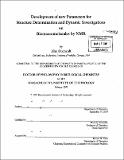Development of new parameters for structure determination and dynamic investigations on biomacromolecules by NMR
Author(s)
Duchardt, Elke, 1975-
DownloadFull printable version (12.51Mb)
Other Contributors
Massachusetts Institute of Technology. Dept. of Chemistry.
Advisor
Harald J. Schwalbe.
Terms of use
Metadata
Show full item recordAbstract
Nuclear magnetic resonance (NMR) spectroscopy is unique in the content of structural as well as dynamic information that it can provide at atomic resolution. The aim of this PhD-thesis was to contribute to the understanding of biochemical processes by means of NMR-spectroscopic techniques, targeting specific problems as well as contributing to the general understanding and providing new, widely applicable methods. The main focus was on the structural as well as dynamic study of ribonucleic acids (RNA). A new structural NMR method was developed aimed at the determination of the glycosidic torsion angle [chi] in RNA, which defines the relative orientation of the nucleobases in respect to the ribose moiety (Duchardt et al., 2004). [Chi] was derived from the angle dependence of carbon-hydrogen dipole-dipole, nitrogen chemical shift anisotropy cross-correlated relaxation rates (gamma-rates). Method development comprised the design of a novel NMR experiment, the [gamma](HCN), as well as the introduction of [gamma] versus [chi] parameterization curves. The novel method provides an accuracy of around 10 degrees or better, comparable to the precision of conventional angle determination techniques. In contrast to conventional methods, the [gamma](HCN) is sensitive to molecular size and will therefore proof beneficial in the investigation of larger RNAs by NMR Apart from this methodological contribution to RNA structure determination, the dynamic properties of the abundant YNMG RNA tetraloop motif (with Y=C or U; N= any base; M=C or A) were studied in a residue specific manner by means of ¹³C NMR relaxation measurements. The dynamics of the extraordinarily stable cUUCGg motif were compared to the less stable uCACGg hairpin, which forms the stem-loop D (SLD) in the regulatory 5'-cloverleaf of coxsackievirus 3B. (cont.) Measurements were carried out at 25⁰C, at which both motifs are stable, as well as at close to the melting point of SLD (43⁰0). Ribose and base moiety specific amplitudes and time-scales of motion were extracted from R₁, R₁-[rho] and the heteronuclear nOe of C₆ and C₁. in pyrimidines and C₈ and C₁. in purines by application of the model-free formalism (Lipari and Szabo, 1982). The application of the model-free formalism to C₁, and C₆ which possess an additional adjacent carbon spin, was examined for the uniformly isotope labeled RNA hairpins investigated in this study. In addition, the relaxation data analysis was optimized for the ¹³C chemical shift anisotropy based on chemical shift tensors available to date (Stueber and Grant, 2002;Fiala et al., 2000). While at room temperature, the dynamics closely follow the structural features of both hairpins, residues in the loop closing as well as in the adjacent base-pair exhibit highly increased flexibility at temperatures close to the melting point of SLD. In contrast, loop dynamics remain unperturbed. In SLD, the residues close to the loop are conserved among the family of rhino- and enteroviruses, indicating a sequence based mechanism of decoupling loop structure and stability in order to adjust to the twofold requirement of a defined structure for protein recognition and low stability to ensure efficient melting within the genomic transcription process. In addition to investigations on RNA, structural studies were also conducted on the [zeta]-chain of the T-cell receptor (TCR) in order to contribute to the elucidation of the early events in T-cell activation. According to earlier studies (Aivazian and Stem, 2000), the extracellular encounter of the T-cell receptor with an antigen is transmitted into the T-cell via a lipid induced structural transition of the TCR [zeta]-chain cytoplasmic domain.
Description
Thesis (Ph. D.)--Massachusetts Institute of Technology, Dept. of Chemistry, 2005. Includes bibliographical references.
Date issued
2005Department
Massachusetts Institute of Technology. Department of ChemistryPublisher
Massachusetts Institute of Technology
Keywords
Chemistry.